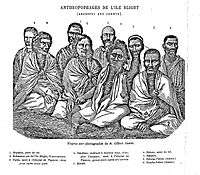Tematagi
|
NASA picture of Tematagi Atoll | |
 Tematagi | |
| Geography | |
|---|---|
| Location | Pacific Ocean |
| Coordinates | 21°40′S 140°37′W / 21.667°S 140.617°WCoordinates: 21°40′S 140°37′W / 21.667°S 140.617°W |
| Archipelago | Tuamotus |
| Area |
61 km2 (24 sq mi) (lagoon) 7.7 km2 (3.0 sq mi) (above water) |
| Length | 11.5 km (7.15 mi) |
| Width | 7 km (4.3 mi) |
| Administration | |
|
France | |
| Overseas collectivity | French Polynesia |
| Administrative subdivision | Tuamotus |
| Commune | Tureia |
| Demographics | |
| Population | 58[1] (2012) |

Tematagi or Tematangi[2] is an atoll in the southeastern area of the Tuamotu Archipelago, French Polynesia. Tematagi's nearest neighbour is Mururoa, which is located 161 kilometres (100 miles) to the ESE.
Tematagi is a medium-sized atoll. It measures approximately 11.5 kilometres (7.1 miles) in length and has a maximum width of 7 kilometres (4.3 miles) with a land area of almost 8 square kilometres (3.1 square miles). As its reef completely encloses the deep lagoon, which is 61 square kilometres (24 square miles), there is no navigable pass to enter the lagoon.
There are many relatively large islands on Tematagi's reef, as well as a few small motu. The main village is Tuihana. There were 58 inhabitants on Tematagi in the last census.
History
The first recorded European to visit this atoll was Captain William Bligh on the ship Providence on April 5, 1792. At the time of Bligh's visit, it was uninhabited. Tematagi Atoll appears in some maps as "Bligh's Lagoon Island".
When Frederick Beechey visited Tematagi in 1826 he found inhabitants there. In 1857, the captain of the Julia, coasting along Tematagi Atoll saw armed natives follow the course of his schooner... "clad in many-coloured stuffs".
Demographic and Population
Father Victor Valleys Catholic missionary who was the Tuamotu Is contributed, with the inhabitants of the atolls and neighboring Reao Pukarua, plant (or restore) the coconut grove Tematagi and other atolls in the region (Maria, Matureivavao, Tenania, Vahaga, Tenararo, Vanavana, Tureia, Vairaatea, Vahitahi). In 1966, Father Victor Valleys mentioned in a letter to Bishop Maze he had planted with teams Paumotu 135,000 young coconut in these islands. Teams of workers from neighboring atolls spent three or four months a year Tematagi to harvest copra. Father Victor is concerned with the Archbishop of contamination Tematagi and surrounding atolls. Legally, the atoll Tematagi did not belong in the public domain of Polynesia: a document states that "the atoll of Tematagi was granted a final license to SCI Tematagi Vanavana in 1974. " This SCI was led by Father Victor and she is no longer active since the latter's death in 1986. For twenty years, some families moved to the village and Tematagi Teakoro was built for the permanent inhabitants. A pontoon landing was built Teakoro and a church and administrative buildings. The legal status of the population is not clear since an atoll is left operating property of SCI, under the guise of the Catholic Mission. Transactions were even made in 1998 between Vice-President of French Polynesia, Mr. Fritch, and Mr. Bruno Wan who prospected the atoll to install the pearl industry. In 2001, the village consisted of 36 residents who live in the exploitation of copra and away from: the atoll has no airstrip and external communications are still radio. Administratively, Tematagi was attached to the town of Tureia.
Antipode of Mecca
Tematagi is the closest land area to the antipode of Mecca. This means that the correct direction of Muslim prayer (qibla) varies widely between Tematagi and its neighboring islands.

Administration
Administratively Tematagi belongs to the commune of Tureia, which includes the atolls of Tureia, Fangataufa, Moruroa, Tematagi and Vanavana.
Images & Maps
|
References
- ↑ "Population". Institut de la statistique de la Polynésie française. Retrieved 9 October 2014.
- ↑ Board of Geographical Names Site Internet: http://geonames.usgs.gov/foreign/index.html
External links
- Tematangi Atoll FP (EVS Islands)
- Thoughts - Antipode of Qibla at Mecca (EVS Islands)
- Shuttle Image ISS004-E-6727 (Astronaut Photography)
- Shuttle Image ISS009-E-6082 (Astronaut Photography)
- Tematangi Atoll FP (Oceandots.com) at the Wayback Machine (archived December 23, 2010)
- Tuamotu Atolls List (Pacific Image)

.jpg)
.jpg)